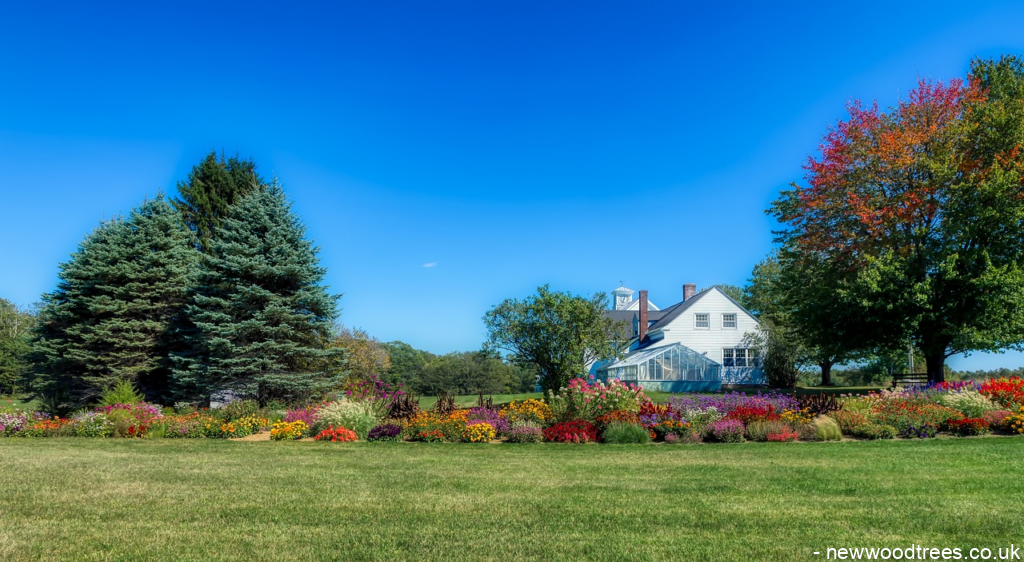
Achieving garden privacy can be challenging, especially if you live in a populated neighbourhood or your yard lacks natural barriers. While walls, fences, and tall shrubs can help block views, large screening trees offer unique advantages when establishing seclusion. With their substantial height at maturity and expansive canopies, certain tree species are ideal for concealing areas of your landscape while contributing shade, beauty, and ecological benefits.
When selecting the right privacy tree, consider your location’s climate and soil conditions, each species’ mature size, growth rate, invasive potential, and other characteristics. Proper placement is also vital – situate screening trees strategically along property borders or position them to hide specific landscape features.
Here are six of the top large evergreen and deciduous trees to provide year-round visual screening in most temperate gardens.
1. Taxus baccata – Yew
The Taxus baccata, or English yew, is a classic screening tree used in gardens for centuries. This dense, slow-growing conifer reaches 30-40 feet tall and 20-35 feet wide at maturity. Dark green needle-life foliage extends down each branch, creating an impenetrable wall of natural green.
Yews thrive in full sun to partial shade and nearly any well-drained soil. They tolerate pollution, salt spray, wind, drought, and root competition. With regular pruning for shape, yews will provide multi-season interest and invaluable privacy for generations.
The English yew makes an excellent anchor and backdrop to showcase more decorative elements in the garden. Its deep emerald hue contrasts strikingly with colourful flower beds, ornamental grasses, Japanese maples, and more. The yew’s horizontal branching pattern allows you to underplant with lower-growing rhododendrons, azaleas, heathers, and spring bulbs.
Even in winter, when the garden sleeps, the yew holds fast with vibrant evergreen energy. Its solid presence frames and highlights surrounding plants and focal points year-round. Furthermore, the tough yew tree is a great way to create a cosy and private garden space.
Sitting under its branches can feel like being in a room, hidden away where you can relax. You could also build a little fountain with the yew planted around it to make it even more peaceful.
The ideas are endless once you use strong trees like yews to give your personal spaces in the garden. Their green leaves make walls around whatever you decide to build. When you go to buy large trees for sale, think about yews and how they can help carve out garden privacy.
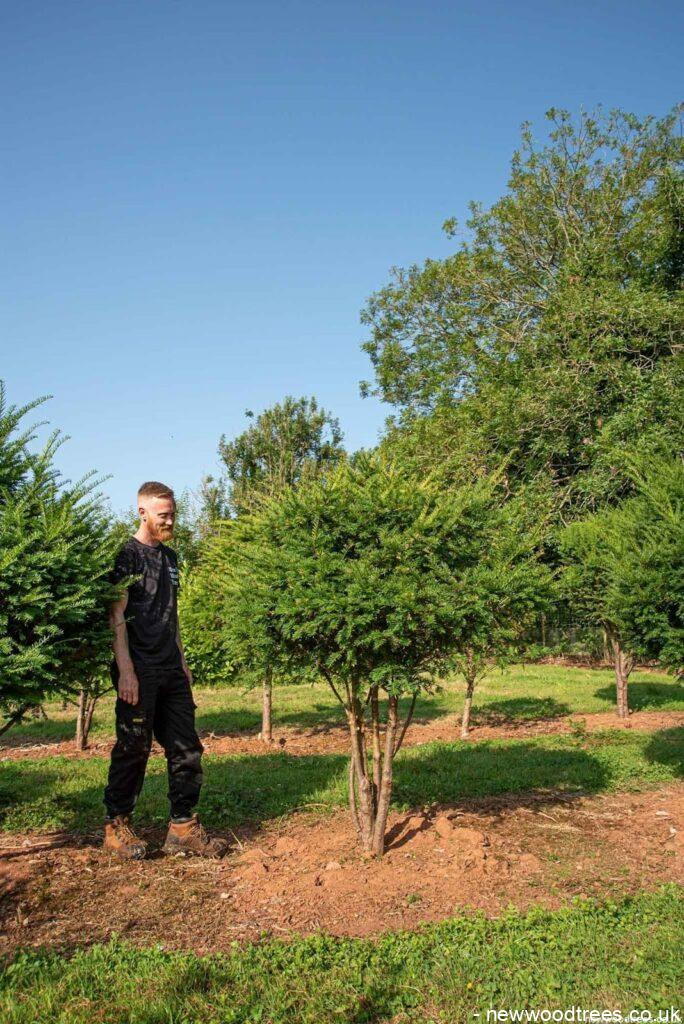
2. Pinus wallichiana – Bhutan Pine
The Bhutan pine is a magnificent evergreen known for its vase-like shape, long blue-green needles, and spicy orange bark. This fast-growing pine reaches 40-80 feet tall and 20-30 feet wide under ideal conditions. The shapely, whorled branches hold the foliage from top to bottom, forming a dense screen.
Native to the Himalayas, Bhutan pine tolerates cold, heat, wind, pollution, salt, and alkaline soil. Once established, it only requires moderate water. The unique indigo cones contrast beautifully with the steel blue needles. Bhutan pine needs ample space to showcase its grandeur as a privacy tree. When pruned periodically, it will reward you with year-round garden privacy.
Furthermore, the Bhutan pine makes a majestic specimen tree but also blends seamlessly into mixed evergreen borders and screens. Underplant it with lower-growing conifers like dwarf spruce, cypress, or false cypress for a lush, layered look. Or use it as a towering backdrop to show off broadleaf evergreen shrubs like rhododendron, camellia, or holly.
For seasonal interest, highlight the Bhutan pine’s striking form by planting swaths of daffodils, crocus, or ornamental grasses at its feet. This beauty from the Himalayas can handle cold winters and hot, humid summers with aplomb. Its spicy orange trunks glow like beacons to illuminate snowy days. Bhutan pine brings drama and elegance to both formal and natural garden designs. Give it space to reach its full potential as a specimen or allow it to intermingle cosily with other conifers and perennials.
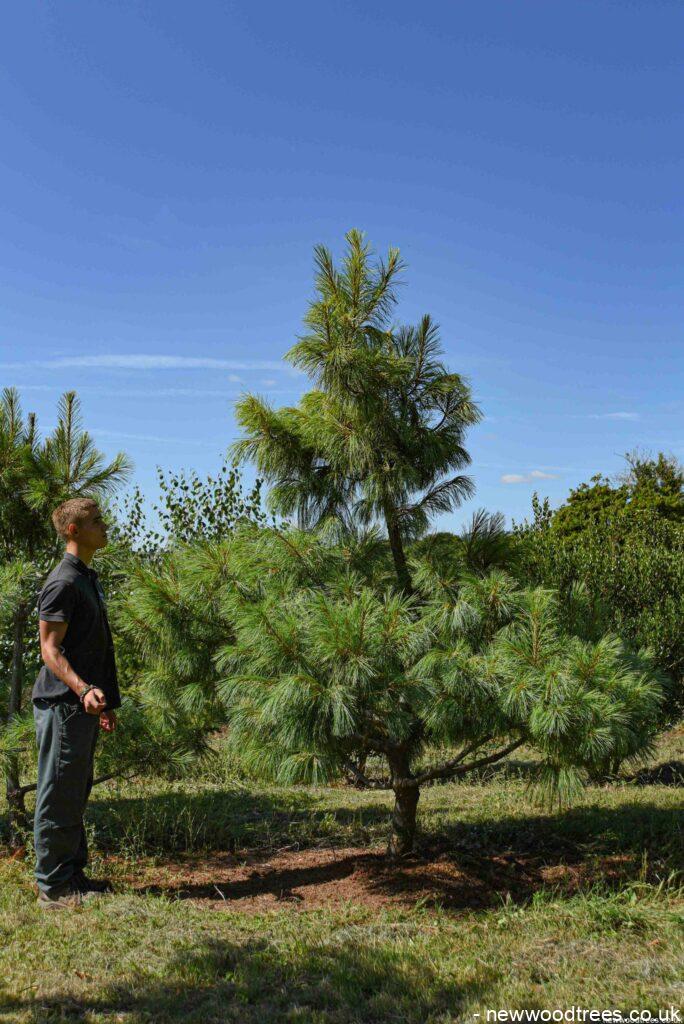
3. Pinus sylvestris – Scots Pine
Scots’ pines withstand pollution, coastal exposure, wind, drought, and poor soils. Their dynamic form looks gorgeous, sparkling after winter storms. Group them closely as a windbreak or tall perimeter hedge with continuous lower growth. Scots pine transplants easily and will quickly grow into a perfect tree for garden privacy.
No large screening tree offers faster, more reliable growth than the Scots pine. This hardy, adaptable evergreen reaches over 75 feet tall with a 25–40-foot spread. Light green needles clothe each branch to the ground. The wispy, layered effect gives great cover from neighbours while allowing filtered light and views.
Additionally, the Scots pine serves many landscape needs at once. Use it as a windbreak to protect more delicate trees and shrubs, or plant it as a screening hedge to obscure unwanted views. Scots Pines grow vigorously when young but become more relaxed with age. Their wispy, irregular shape contrasts beautifully with neatly pruned hedges and topiaries. Underplant them with flowering shrubs like azalea, viburnum, and forsythia. Purple coneflower, black-eyed Susan, and Russian sage complement the Scots pine’s wild character.
You can also use them to frame crisp perennial beds, vegetable gardens, and cutting gardens. Their reliability and adaptability to various garden styles and sites make Scots pine ideal for designs from refined too naturalistic. They pair equally well with native plants, herbaceous perennials, and roses. Scots pine anchors any space with graceful strength.
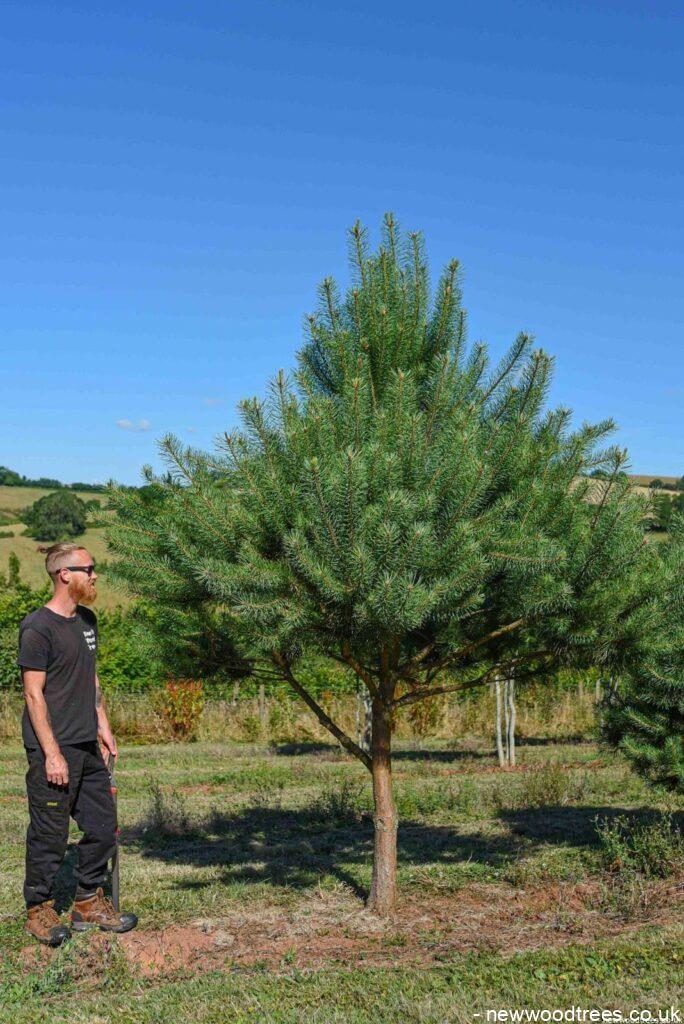
4. Pinus nigra – Corsican Pine
The Corsican pine is similar to the Austrian pine but more compact and easier to integrate into home landscape designs. This fast-growing, upright evergreen reaches 40-60 feet tall and 20-30 feet wide at maturity. Short, twisted, deep green needles densely clothe all branches.
Corsican pine handles heat, wind, salt spray, drought, air pollution, and alkaline soil. It needs well-drained soil and full sun for the best form. The layered, interlaced branches ensure no one can peek through its screen. Vigorous when young, the Corsican pine makes an enduring, versatile hedge with reliable coverage from top to bottom.
Besides, the dense, interwoven branches of the Corsican pine create a sheltering enclosure and intriguing glimpses of the landscapes beyond. Underplant it with low-growing junipers or creeping phlox for a colourful carpet below. Weave curved flagstone pathways in and out of the pine’s reach to craft a living maze or labyrinth. Nestle boulders, garden art, and rustic benches are within their parameters to craft intimate, semi-private refuges. The Corsican pine’s tiered form creates a dramatic living wall or buffer between garden rooms.
Use it to define separate spaces for vegetables, perennials, annuals, or cutting beds. Its fast growth rate quickly fills the screening role while allowing flexibility in garden layouts. Pair the sturdy Corsican with ornamental grasses for textural contrast or other conifers for year-round interest. This adaptable pine transitions well between formal symmetrical and informal asymmetrical designs. Tuck several close together to establish an impassable hedge or stand a single specimen on its own for an architectural element.
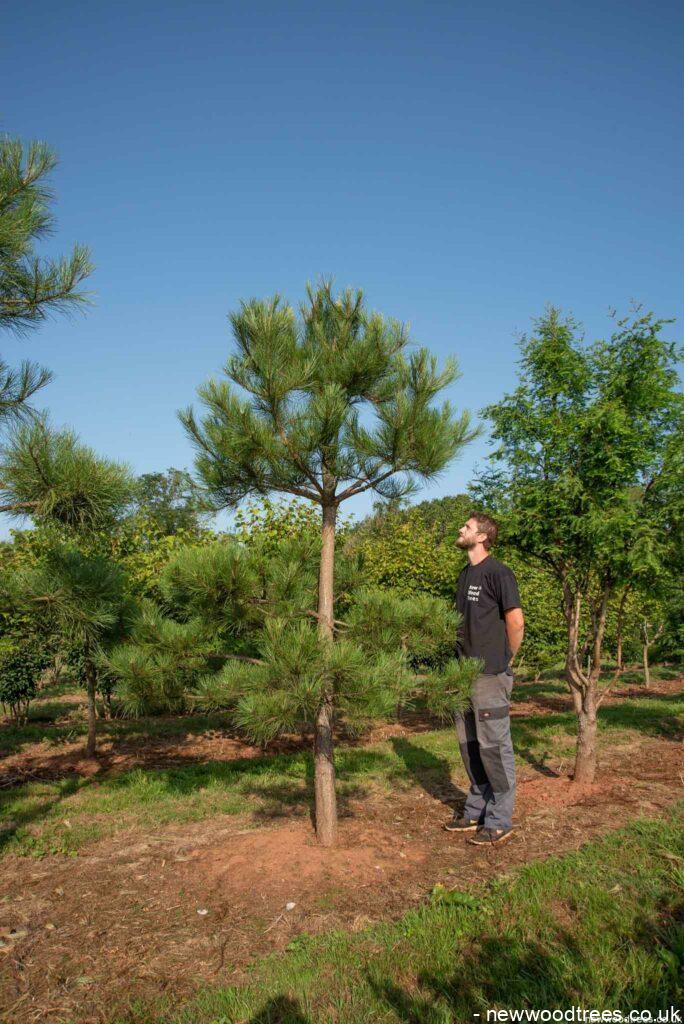
5. Pinus nigra – Austrian Pine
Austrian pine is a rugged cold-climate tree that inserts itself prominently into any landscape with its wide, domed habit. Eventually growing 50-60 feet high and 25-35 feet wide, Austrian pine moves swiftly to fill its screening duties. Stiff, rounded, evergreen needles emerge bright green before darkening to a rich green.
This adaptable pine withstands wind, drought, salt, pollution, heat, humidity, and poor soil. Regular shearing when young will encourage dense growth. The long, swooping branches layer nicely to block views while allowing winter sunlight to filter through. Austrian pines combine fast growth with year-round screening for sufficient garden privacy.
Moreover, the Austrian pine can fit into any garden thanks to its stalwart constitution. Its rounded form softens corners between buildings and openings to new garden vistas. Underplant it with low-growing heathers, heuchera, juniper, or liriope for contrast and year-round appeal. Allow the pine’s sheltering boughs to stretch over crushed stone or gravel pathways, stone walls, and alpine gardens.
The pine needles form a lovely natural mulch that suppresses weeds beneath. Tuck hypertufa troughs filled with alpine plants in and around Austrian pines for added interest. Or spotlight the pine’s strong shape by surrounding it with emerald, green lawns or neat perennial beds.
Flowering dogwood or Japanese maple offers stunning colour contrast as understory planting partners. Wherever it’s placed, the Austrian pine steadily extends its protective reach. Trust it to screen harsh winds in winter and filter summer’s heat and light. Austrian pine forms living canopies above your heads and barricades along your borders.
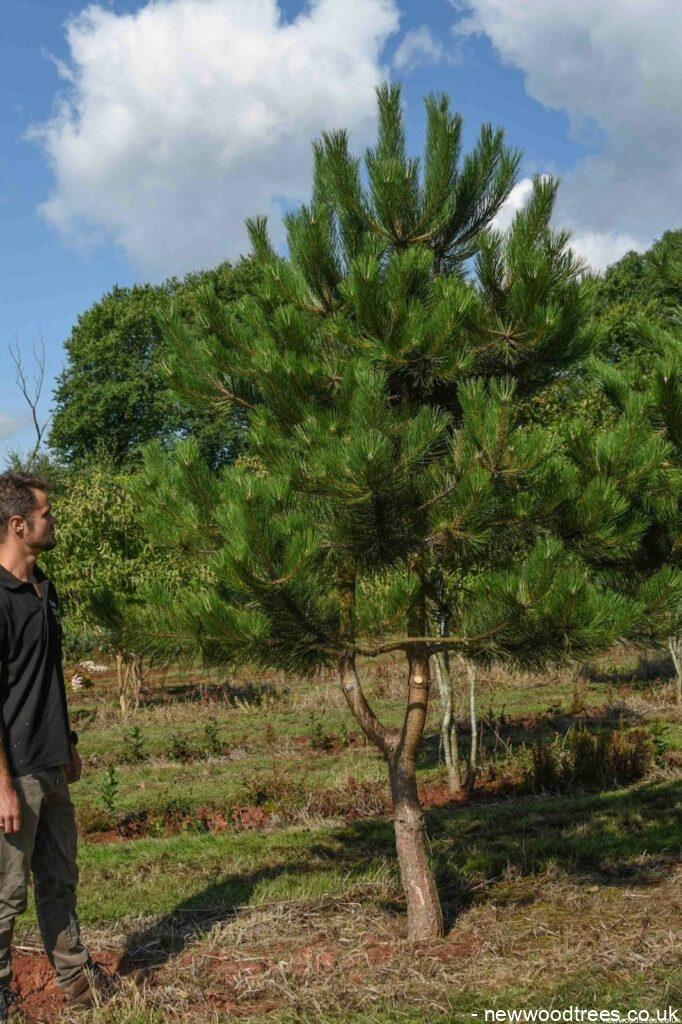
6. Carpinus betulus – European Hornbeam
Technically a deciduous hardwood tree, the European hornbeam offers impenetrable coverage with spectacular fall colour. It fills out a broad, oval form reaching 30-60 feet tall and 40-60 feet wide. The smooth grey trunk supports wide-spreading branches adorned with pointy, toothed leaves.
Fast-growing in youth, hornbeams tolerate almost any soil, exposure, heat, drought, or humidity. The branches grow predictably horizontally for excellent screening density. Breathtaking orange and maroon fall foliage is an amazing bonus. Mix hornbeams with evergreens for stunning contrast and multi-season privacy. Plant hornbeams closely to form a dense, uniform hedge of arching branches and bright green leaves.
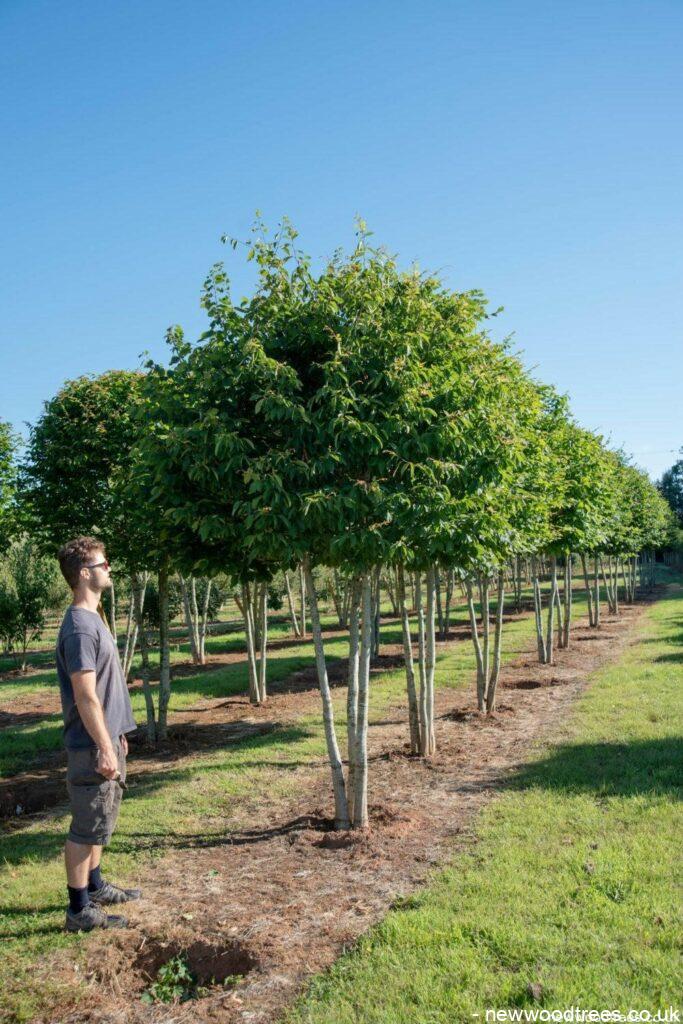
Conclusion
When choosing trees to maximise garden privacy, consider foliage density, growth rate, mature size, and overall resilience to create lasting refuge. The best privacy trees build natural barricades with little maintenance needed. You can cultivate outdoor rooms that provide sanctuary from the world beyond your garden gates by selecting the right large screening trees for your specific growing conditions and design aesthetics.
The imposing yews, stately pines, and graceful hornbeams described here represent the gold standard for evergreen and deciduous coverage. Their towering yet welcoming presence immediately communicates the privacy and seclusion you desire. Let these living walls form the protective border to make your landscape your own. Within their verdant bounds, comfort and solitude await.






